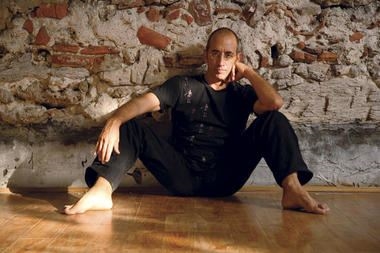 |
| Alvaro Restrepo began El Colegio del Cuerpo (The Body School) by partnering with a local school in Cartagena, Colombia. His troupe now tours and trains – and addresses issues far beyond dance. |
Cartagena de Indias, Colombia
Had Yarisel Castro, a petite, soft-spoken young woman from a tough neighborhood of Cartagena, not found El Colegio del Cuerpo (The Body School), she says she would probably be what most of her school friends are today: a teenage mom with no career prospects.
Cartagena, Colombia, conjures up the image of a Spanish colonial paradise on the Caribbean Sea. But in the sprawling slums on its margins, girls like Ms. Castro show another face of this port city, where racism, rigid social classes, and a lack of education hold many down.
When she was 12, Castro saw a performance in her school by The Body School, cofounded by dancer and choreographer Alvaro Restrepo. It changed her life.
Castro joined the school and now, nearly a decade later, she says she dreams of opening her own dance school one day. "I want to help others the way Alvaro has helped me," she says. "Here they taught us to treat our body well, not to do damage to it with alcohol or drugs. I want to make others conscious that they can be free and express themselves in another way."
Castro is one of scores of young people from Cartagena who have changed their lives at The Body School. Mr. Restrepo, an internationally known dancer, founded it along with French dancer and choreographer Marie France Delieuvin in 1997. The school has a professional troupe and training school, as well as myriad educational programs that focus particularly on children from slums or individuals displaced by the paramilitary and guerrilla conflicts in rural areas.
Restrepo created The Body School as a response to what he sees as a crisis in Colombia, a nation torn by violence and stubborn class divisions. "All kids are so threatened in this city," says Restrepo in his office as he multitasks between his constantly ringing cellphone, dance classes and rehearsals, and managing student travel schedules and visa issues. "There is violence, sex tourism.... Our new center wants to be a revolutionary laboratory of social inclusion."
The Body School began by partnering with a public school in Cartagena. Some 450 students, ages 10 to 12, rotated in and out of three-month dance workshops. After a rigorous selection process, 18 boys and girls became the core company of the school. They began performing publicly in 2000.
Over the past 13 years, the troupe has gained worldwide recognition, touring Europe, the United States, Latin America, and Asia. Aside from its professional work, The Body School also runs the program Education With Dance, which teaches needy children about nutrition, the dangers of drug addiction, their rights, and their individual identity through dance and body movement.
Juan Guillermo, a professional dancer with the troupe who was one of the first youths to join the program, was left wide-eyed when he witnessed contemporary dance with Restrepo and Ms. Delieuvin for the first time, he says. Many years later, the school continues to bring life-changing experiences to children, he says, and not only in professional careers as dancers or dance teachers.
"It has helped so many young people develop values and respect their own bodies," he says.
Like every child in her neighborhood, Castro grew up dancing to whatever music was in the streets. But she got serious when she joined the training school eight years ago, combining her formal education with a demanding dance schedule that often keeps her going late into the evenings.
Her decision wasn't welcomed by her mother, who sells candies in a kiosk and wanted her eldest daughter to become an English teacher and pitch in more with family chores.
"She always reminds me, dancing does not last forever," Castro says. But dancing has changed her life, Castro says, by giving her a new way to express herself. Without it, "I would not know differently, like my old friends," she says.
Restrepo says many motivations drew him back to Cartagena, where he had spent summers as a child. One came from his mentor, South Korean choreographer Cho Kyoo-Hyun, who said to him while he was studying in New York City: "You have to go back to your country. You have to be the Gabriel García Márquez of dance," referring to the Colombian novelist who won the Nobel Prize in Literature in 1982.
In the late '70s, when Restrepo was studying piano and thought he might want to become a poet, he met a priest working with street kids in Bogotá, the capital of Colombia, which set him thinking.
"We do not value children's potential. I met so many children that were forgotten," he says.
That drove him first into theater, with the goal of using it as a teaching tool, and later to dance.
Today he does not see his mission as purely social work. "If it is just social work, yes, it takes kids away from the street, they use their free time creatively, but you are not challenging them with a life project," he says. "I do not want to work with just poor kids – or rich kids. I want to work with talent."
Colombians are classified as belonging to one of six social classes. When Restrepo is asked which class the kids in The Body School come from, he replies, "Strata T" for "talent."
The school is about to move outside Cartagena onto five acres of land donated by the mayor and is launching a fundraising effort. The first building to be constructed will be called Athanor, In alchemy, the word refers to the furnaces where valuable concoctions are forged.
"It has a symbolic meaning," Restrepo explains. "It is where we make gold out of human beings."
Page created on 8/4/2014 4:03:51 PM
Last edited 8/4/2014 4:03:51 PM
